|
Meet
Buddy Besette. Buddy is handicapped and confined to
his wheelchair when he ventures outside his house.
But he's an independent-minded soul, and he can
squeeze 20 miles out of his battery. It gets boring
at home, he says, so he takes periodic trips to the
mall. The people at Ukrops grocery store and other
shops are always nice to him -- they give him free
things to take home.
|
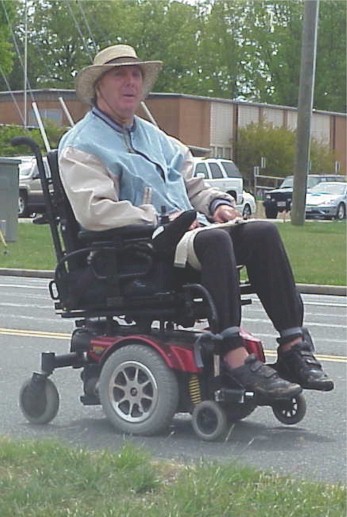
|
To
brave the 'burbs in a wheelchair, Buddy must be the most intrepid man in
Henrico County. He doesn't ride on sidewalks to get
where he wants to go. The network of sidewalks
in western Henrico County is so patchy and
incomplete that he takes to the street.
Riding
on four-lane roads where traffic
speeds past at 40 miles per hour, Buddy acts as if he
owns the road. It's a testament to the
|
good
nature of Henrico County motorists that
no one seems to mind him slowing down
traffic. People just wait for an opening in another lane and drive around. The
police, he says, wave to him.

Buddy
crossing the street at the intersection
of
Gaskins and Gayton roads.
If
Buddy takes his life in his hands every time he
wheels off to the mall, it's not for a lack of
sensitivity towards the handicapped on the part of county
government. The good bureaucrats of Henrico have
gone out of the way to accommodate people like
Buddy... or so they think.
I
have an image in my head that, ensconced in the
bowels of the Henrico County planning department,
there sits a gnomish little man in charge of
sidewalks. He has pale skin, a long, pointy nose and
bulging eyes. Dressed like Bartleby the Scrivener
with a high, starched collar, he wields a quill-tip
pen and applies the rules with rigid consistency --
and with utter disinterest in their real-world
impact. If the regulations
say sidewalks must be handicap accessible, then,
by Jove, they will be handicap accessible!
Of
course, if the sidewalks are so useless that Buddy
takes instead to the streets... if the sidewalks
lead nowhere that anyone would want to go... if the
streetscape is so inhospitable that even able-bodied
citizens spurn walking... that's someone else's
department.
Modern-day
suburbia is full of absurdities. I have
chronicled some of them in previous columns. (See
"Lost
in Suburbia," Oct. 17, 2005, and "Pod
People," April 3, 2006) but I barely
scratched the surface. Today, I turn my gimlet gaze on
sidewalks, an aspect of our physical surroundings so
pedestrian (pun intended) that it warrants little
public scrutiny. These Rodney Dangerfields of our
civic infrastructure are critical pieces of any
transportation system, for they provide mobility for
people who choose to travel on foot.
In
traditional towns and cities, sidewalks are terribly
useful: People walk on them to get places. Indeed,
people use them quite frequently. But there are
certain distinguishing characteristics of sidewalks
in cities that get lost in the scattered,
disconnected, low-density dystopia of American
suburbia.
In
cities, sidewalks connect real destinations --
houses, corner stores, restaurants, offices, and the
like. In the 'burbs, sidewalks appear to be
installed at random, connecting almost nothing at
all.
In
cities, there are buffers between the sidewalks and
traffic, allowing pedestrians to feel safe. Most city streets have parking lanes,
usually with cars parked in them, which provides a
veritable wall between pedestrian and motorist. In
the 'burbs, there typically is nothing but a curb
and gutter
separating the pedestrian from on-rushing cars. The
walls, if they exist at all, usually consist of
fences separating the sidewalk from the houses,
not the roads!
In
cities, sidewalks link destinations in a grid-like
web. There are many alternative routes between two
choices, most of them fairly direct. In 'burbs,
sidewalks enjoy little connectivity; the path
between two points is long and circuitous.
Finally,
in cities, sidewalks are an integral part of a
streetscape that includes trees,
ornamentation and buildings abutting the sidewalk.
The scale is human and the surroundings inviting.
There is always something to engage the pedestrian's
interest.
In the 'burbs, sidewalks are not integrated into the
streetscape; they are a useless appendage
to roads designed for the rapid
movement of automobiles.
Now,
let's take a look at what I'm talking about.
Consider
the intersection of the John Rolfe and Ridgefield
parkways in Henrico County, a paragon of modern-day
traffic engineering...
There
is a shopping center in the corner of the
intersection from which I took the photo and a gated
subdivision across the way, but there are no destinations that anyone would consider
walking to, much less hobbling to in a walker or
rolling to in a wheel chair. Nonetheless, someone very thoughtfully ran
sidewalks in every direction and even installed
handicap-accessible curb cuts.
|
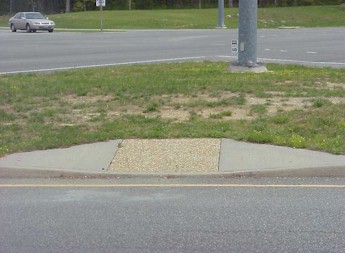
|
As
you can see, it's a bit of a bumpy ride for a
wheel chair from the curb cut to the other
side of this little traffic island. Someone neglected to extend the sidewalk
here. But the distance to the next curb cut isn't far, so it would |
have to be a pretty querulous cripple to
complain.
Now,
imagine yourself as Buddy Besette, or just an
ordinary pedestrian, on a stroll through the
suburbs. Here's the street you have to cross.
|
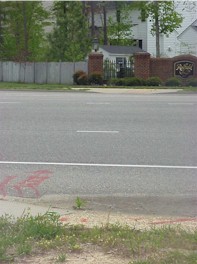
|
Inviting,
eh? A veritable Special Olympics obstacle
course! No
marked pedestrian pathway. Just seven
lanes of traffic coming and going every which
way. (You can't see all the lane markings
in this photo. Trust me, though, I counted
them.)
Placing
sidewalks at intersections like John Rolfe and
Ridgefield might have made a modicum of sense if
they had allowed the residents of the
sub-
|
division
seen in this photo to access the
shopping center from a convenient egress. But
pedestrians get out of the gated community the same
way as the cars do: through the main entrance. If you
were crazy enough to try reaching the shopping
center on foot, you'd have to take a round-about
course through the spaghetti streets of your
cul-de-sac to the entrance on Ridgefield, and then
walk a couple hundred
yards along the featureless parkway. Most people
would just take the car.
It
is no exaggeration to say that many suburban
sidewalks are "paths to nowhere." This
pathway alongside Ridgefield Parkway (below) ends abruptly
for no apparent reason. Of course, as you can tell
from the photo, it's not as if the sidewalk would
have reached any meaningful destination even if had
it had kept going. It looks as if the
contractor realized the utter futility of building
the thing and just abandoned the job.
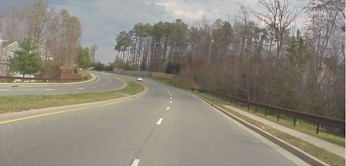
You
rarely see even able-bodied people using these suburban
sidewalks, but there are occasional exceptions. I spotted a teenage girl walking
along a long, desolate stretch of sidewalk and
pulled my car into a turning lane ahead of her.
Curious, I hopped out with my camera, hoping that she
would tell me her story (and not bolt in fear,
thinking that no one but a freak or a pervert would
stop to talk to her in such an unlikely location).
|
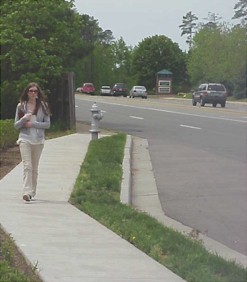
|
This
photo, taken where the sidewalk takes a dogleg
away from the main road, doesn't capture just
how inhospitable it is for walking. See the
photograph above for a better idea of what a
pedestrian faces on Ridgefield Parkway. |
The
17-year-old girl, who identified herself only as Kelly, was on her way home from
the video store. She lives in a subdivision pod
disconnected from anything and everything, so she normally drives a car.
Today was a different: It was literally the first time,
she said, that she'd ever used the
sidewalks. But with gasoline at $3 a gallon, she'd
thought she'd save some money and have a little
adventure walking to the video store.
A
friend of hers from Paris remarked on how it strange
it felt to take a car everywhere she went in Henrico
County, Kelly volunteered. In Paris,
the friend told her, she walked everywhere. But
Henrico ain't Paris. The county was designed for the
mobility of cars, not people on foot.
Here's
what's crazy. It's one thing to design the community
around the car. But if you do, why waste your
money on building sidewalks nobody uses? Tell me,
would you choose walking on this sidewalk on
Gaskins Road as a mode of conveyance, even if it
took you somewhere you wanted to go -- which it
doesn't?
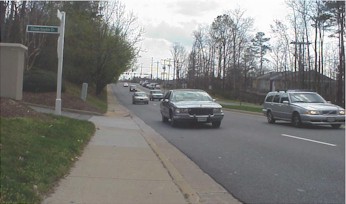
Ah,
there's nothing like the fragrance of exhaust and the
wafting turbulence of the slipstream from cars zooming past
at 45 miles per hour. There's nothing quite so
exhilarating as wedging between a berm and two-ton
hunks of steel flying past at barely an arm's length
distance!
Now,
just one more example, my favorite...
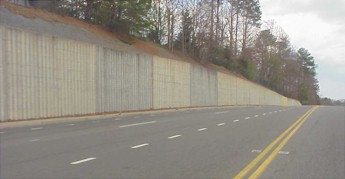
No,
that tiny leaf-lined strip of beige between the
retaining wall and the road is not the curb -- it's
a narrow sidewalk! If
you think that sidewalk uninviting, do remember, it
could be worse. Public Works could have lined the
path with punji sticks or looped it past an open
cesspool. (Uh, oh, I hope I didn't give anyone any
ideas!)
Seriously,
if anyone in the
Henrico County planning department thinks its
sidewalks are providing pedestrian mobility, they're
only deluding themselves.
My
purpose is not to belittle Henrico County planners.
For a jurisdiction that has abandoned the city
street grid pattern of development, Henrico is
pretty well laid out. In any case, the problem isn't
individual planners. I've spoken to a number of
them, and none of them are gnomes. They've all
struck me as intelligent people motivated to build a
more livable community.
The problem is the
ossified compendium of zoning codes, subdivision
ordinances and capital improvement plans that leaves
no room for creativity or initiative. Henrico, like
most every other county in Virginia, would be well
served by scrapping its codes and starting over with
an new vision of what sidewalks and streets could
look like.
Andres
Duany and his wife Elizabeth Plater-Zyberk,
prominent spokesmen for the New Urbanism movement,
describe modern parkways as "automotive
sewers" designed solely for moving an endless
flow of cars. As an alternative to these sterile sluices, the two
architect- planners offer the
traditional street-lined boulevard. "Instead of
an intimidating four-laner," they write in
their 2000 book "Suburban Nation,"
"this boulevard is a twelve-laner: six lanes of
traffic and six of parking. Yet this roadway is so
charming and comfortable, thanks to its avoidance of
high-speed geometrics, that residents pay good money
to sip coffee at curbside cafes."
Sipping
coffee on Ridgefield Parkway? Not unless the coffee
is in a foam cup and you're behind the wheel. If
Henrico County were concerned with building better
places rather than moving more cars, it could do no
better than to seek inspiration in
nearby Richmond. Monument Avenue is not only one of the
grandest boulevards in the South, a place where
houses sell at a premium to face the thoroughfare,
but it moves thousands of cars in and out of
downtown Richmond every day.
Protestations
to the contrary, there's no shortage of paved
surface in Virginia's
suburbs. The scandal is that these assets
are so poorly arranged, that parkways destroy real
estate value rather than enhance it, that so much investment is
wasted on sidewalks leading nowhere, and that so
much roadway is tucked away in cul de sacs where no one but a
handful of families ever touch tire to asphalt.
Buddy
Besette has adapted to his Kafkaesque surroundings.
But he's more resilient than most of us. We need to
find a better way.
--
May 1, 2006
|
